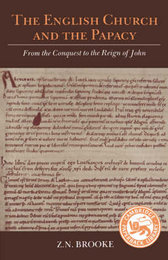
|
The English Church and the Papacy: From the Conquest to the Reign of John
Paperback / softback
Main Details
| Title |
The English Church and the Papacy: From the Conquest to the Reign of John
|
| Authors and Contributors |
By (author) Zachary Nugent Brooke
|
|
Introduction by Christopher N. L. Brooke
|
| Physical Properties |
| Format:Paperback / softback | | Pages:288 | | Dimensions(mm): Height 216,Width 140 |
|
| Category/Genre | British and Irish History
World history - c 500 to C 1500 |
|---|
| ISBN/Barcode |
9780521366878
|
| Classifications | Dewey:282.42 |
|---|
| Audience | | Professional & Vocational | |
|---|
| Edition |
2nd Revised edition
|
| Illustrations |
Worked examples or Exercises
|
|
Publishing Details |
| Publisher |
Cambridge University Press
|
| Imprint |
Cambridge University Press
|
| Publication Date |
13 July 1989 |
| Publication Country |
United Kingdom
|
Description
Since this book was first published in 1931 the English church in the eleventh and twelfth centuries has been studied in depth, yet Z. N. Brooke's The English Church and the Papacy, now reissued with a new introduction by C. N. L. Brooke, remains the indispensable point from which all expeditions over this territory begin. The author set out first to determine what the law of the English Church was, and to seek the books on which it was based; then to draw out the consequences of what he had discovered in a general survey of the relations of England and Rome. The crisp, clear judgements on themes and characters in the second half are still worth pondering, for all the nuances that have been added since.
Reviews' ... one of the half-dozen critical studies which are fundamental to our appreciation of the history of England in the times of the Norman and Angevin kings. It is a masterly piece of work, whether we regard it as an example of historical method or as an exposition.' Sir Maurice Powicke, The Cambridge Historical Journal ' ... a most remarkable piece of historical reconstruction, which will certainly influence all future work on English ecclesiastical history in the eleventh and twelfth centuries.' Sir Frank Stenton, The English Historical Review
|